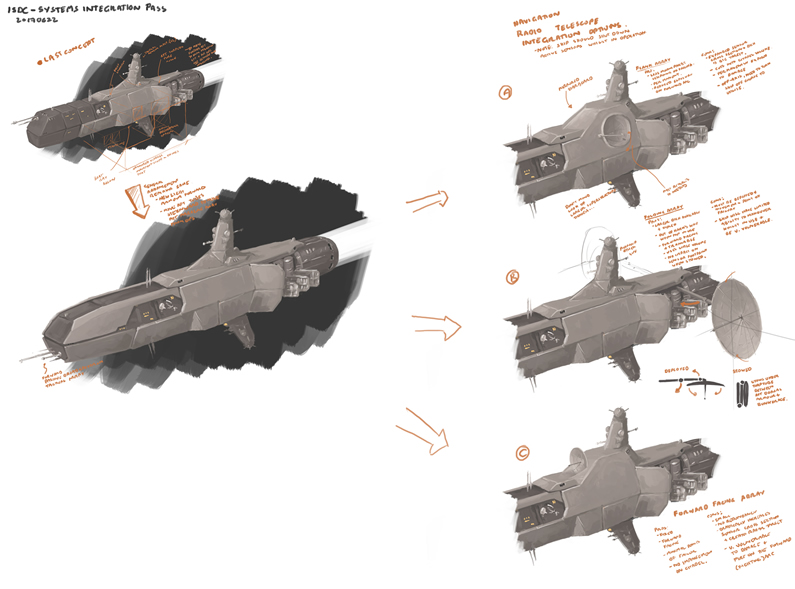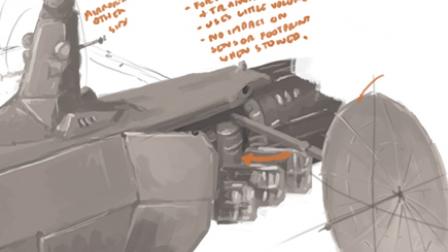
With the vessel's basic form mostly locked away, the design team has been able to begin refining the design, based on feedback from previous passes.
As part of this, more detailed rough-in integration of major systems into the space frame is now also being addressed.
Primary among these, as perhaps one of the more potentially unwieldy systems, in the long-range navigational radio telescope.
Three concepts have been produced to illustrate how this system may be mounted on the vessel, each with their own advantages and disadvantages: a flank mounted array, a collapsible dual array, and a permanently mounted forward facing array. 
Flank Permanent Array (a)
The flank array probably represents the most robust of the three options. However, in order to get sufficient depth to the telescope dish for more accurate imaging, it would require raising of the ship’s superstructure. Pros and Cons are as follows:
Pros:
- As a permanently mounted array, it has very few moving parts, and thus few points of failure.
- Being mounted in the ship’s side it is less susceptible to damage from space borne micro particles or enemy fire. This is additionally enhanced by the intention to mirror the pictured port array on the ship’s starboard.
- The mounting, with revised superstructure, allows for a large dish.
Cons:
- The raised superstructure will increase the ship’s cross-section, making her more easily detected by passive and active sensors, as well as more susceptible to incoming fire. Additionally, the permanently deployed dish makes a fine radar target.
- The dish’s location, though somewhat offset by the raised superstructure, cuts into the vessel’s internal volume, including into the armoured citadel over which it is placed.
- While mitigated by the flank mounting, by being permanently deployed the dish is more susceptible to damage than a stowed system.
- As the dish is mounted off-axis, the vessel will need to turn in order to bring it to bear down its intended course. This creates additional manoeuvring time, as well as meaning the vessel will not be able to accelerate or decelerate down its intended course whilst navigating.
Deployable/folding Array (b)
The deployable array allows for the largest, and thus highest fidelity, receivers of the three options.
Pros:
- Largest available area, and stereoscopic when both sides deployed in consort.
- Share axis with the vessel’s thrust vector, and somewhat trainable.
- Takes up minimal volume when stowed, and does not create weak points in citadel.
- No impact on vessel’s sensor footprint when stowed.
- Protected from damage across most arcs when stowed.
Cons:
- Deployment system introduces potential points of mechanical failure, somewhat mitigated by having a redundant pair.
- Will require time to deploy.
- Fragile when deployed: will severely limit the vessel’s ability to manoeuvre when deployed without potential damage to support frame/deployment mechanics. Vessel will be vulnerable whilst in use.
Forward Facing Permanent Array (c)
The forward facing permanent array represents the most easily operated location. However, it is also limited in size, limiting its fidelity, and requires the same raise superstructure as the flank array.
Pros:
- As a permanently mounted array, it has very few moving parts, and thus few points of failure.
- Shares axis with the vessel’s thrust vector. Coupled with having no deployment time, this makes it immediately available whenever required.
- With raised superstructure, does not impinge upon existing hull volume or citadel.
Cons
- Small, limited by need to minimise forward sensor signature, with reduced fidelity.
- Single mount, no redundancy.
- Location and raised superstructure increase ship’s sensor signature, and the permanently deployed dish makes a fine radar target across the vessel’s primary fighting and approach arc.
- Location makes it more vulnerable to damage than the other two options: both from micro particles and debris, and from enemy action.
It is the designer’s current feeling that the deployable array represents the best option among the three though, should it be adopted, operational procedure would need to be put in place to minimise the risk of damage to the system when deployed.
- 5 comments
- Log in or register to post comments
Comments
Size & shape of array
Does the array have to be circular to achieve it's purpose? Could it be elliptical or even more square to better fit with the vessel's design?
Also, it looks pretty huge comapred to the vessel (which is at least a few decks high, I imagine?)
Dish enhancement fields could be useful here?
My team has been doing work on improving the effectiveness of the dishes at ATCA, using field generators to manipulate incoming spectrum. This allows us to divert more of the desired spectrum towards the dish focal point than the physical size of the dish alone would otherwise allow. It also allows us to divert unwanted spectrum away from the dish (cleaning up incoming data).
In theory changing the shape of the field would allow you not only to extend the effectiveness of a smaller dish but also its shape? I'll have one of my team pass on our research to date (we don't have it in LIAIS yet).
I'll have to get one of the
I'll have to get one of the engineers to help you with that. The field generation equipment they've been adding to the dishes seems very low-profile, though.







